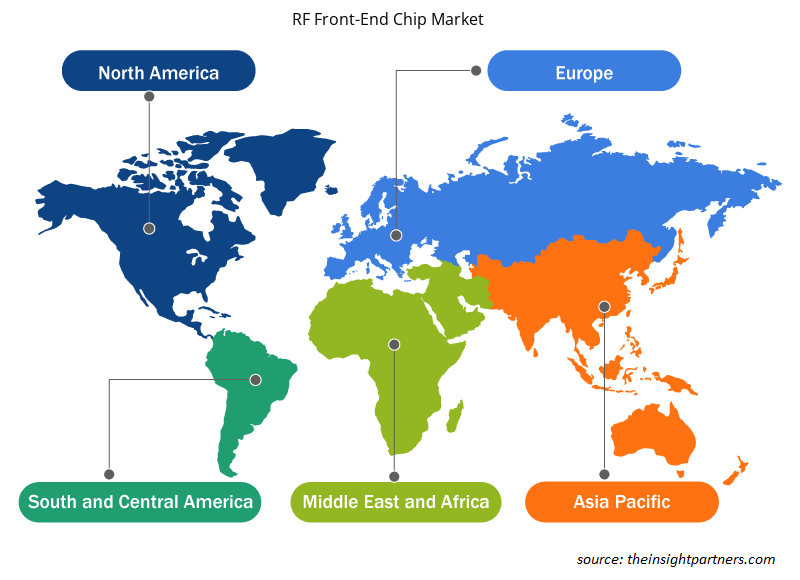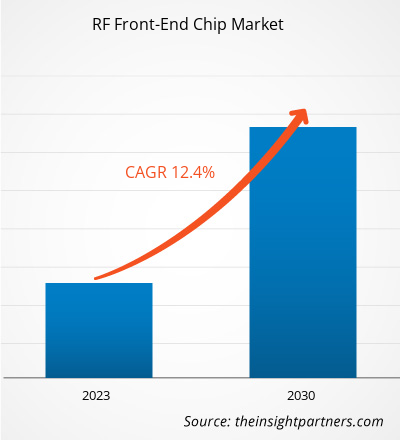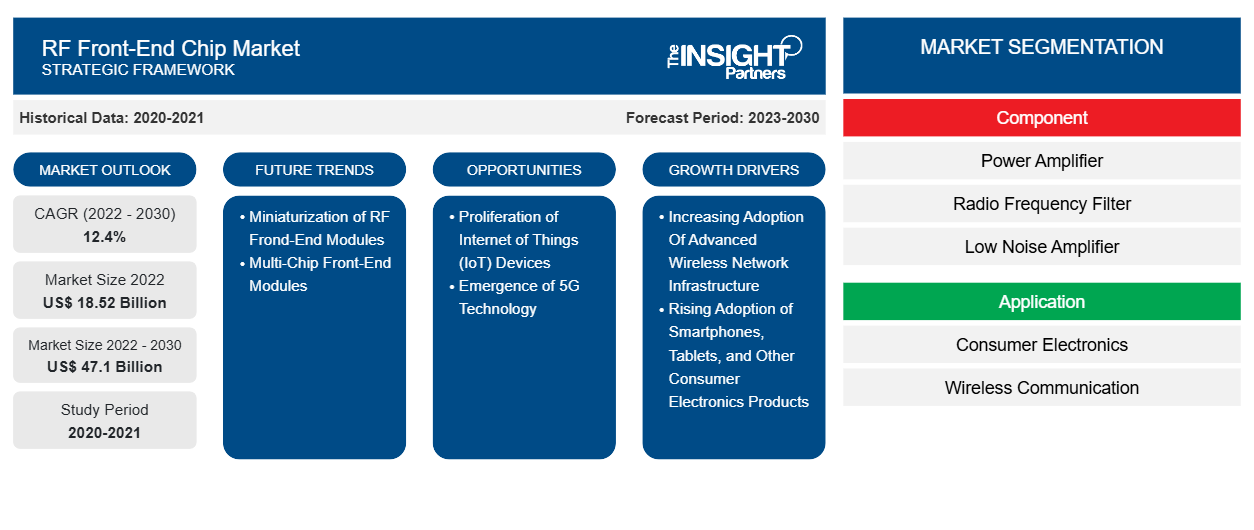[研究报告] 2022年射频前端芯片市场价值为185.2亿美元,预计到2030年将达到471亿美元;预计2022年至2030年的复合年增长率为12.4%。
分析师观点:
智能手机、平板电脑和其他消费电子产品的需求增加,加上 5G 网络的全球推出,推动了射频前端芯片市场的增长。此外,无线通信、物联网和人工智能的发展推动了市场的增长。作为无线通信设备和系统的重要组成部分,射频前端芯片处理射频信号的传输和接收。这些芯片在提高信号质量、提高数据传输速度和降低智能手机、平板电脑和物联网等移动设备的电池消耗方面发挥着重要作用。由于对高速数据传输的需求激增和无线通信技术的快速发展,射频前端芯片市场正在迅速扩大。随着 5G 网络的发展,对能够支持多模式、多频段操作的射频前端设备的需求也在增加,从而实现更好的网络连接和更快的数据速率。此外,射频前端模块和多芯片前端模块的小型化预计将在未来几年带来新的射频前端芯片市场趋势。
射频前端芯片市场概况:
RF 前端芯片是指天线和数字基带系统之间的所有部分。对于接收器而言,这个“之间”区域包括所有滤波器、低噪声放大器 (LNA) 和下变频混频器,用于将天线接收到的调制信号转换为可接受的基带模数转换器输入信号。RF前端是一种设备或模块,包含将天线连接到接收器的至少一个混频级和发射器的功率放大器的所有电路。它们用于各种 RF 商品和应用。示例包括 Wi-Fi 和 FM 无线电系统。
定制此报告以满足您的需求
您可以免费定制任何报告,包括本报告的部分内容、国家级分析、Excel 数据包,以及为初创企业和大学提供优惠和折扣
-
获取此报告的关键市场趋势。这个免费样品将包括数据分析,从市场趋势到估计和预测。
射频前端芯片市场驱动因素:
智能手机、平板电脑和其他消费电子产品的普及推动了射频前端芯片市场规模的增长
根据 GSMA 的年度《2023 年移动互联网连接状况报告》(SOMIC),截至 2023 年 10 月,全球超过一半(54%)的人口(约 43 亿人)拥有智能手机。智能手机的数量正在大幅增加。例如,根据爱立信和 Radicati Group 的数据,2020 年智能手机数量为 57.5 亿部。预计到 2024 年,智能手机数量将增加到 69.3 亿部,到 2025 年,智能手机数量将达到 71.5 亿部。此外,平板电脑近年来越来越受欢迎,因为它们比传统笔记本电脑和台式电脑具有一系列优势。平板电脑、智能手机、耳机和可穿戴设备等联网设备的日益普及进一步推动了对 RF 前端芯片的需求。智能手机和平板电脑通常支持许多无线服务,包括跨多个频段的 FM 广播和 LTE。同时,越来越多的智能手机和平板电脑使用多个天线来提高灵敏度并减少串扰。微型射频固态开关在智能移动设备的射频前端设计中起着至关重要的作用。消费者期望无缝连接和高数据速度,这促使制造商将先进的射频技术融入其设备中。因此,各种市场参与者都推出了智能手机的射频前端解决方案。例如,2020 年 5 月,恩智浦半导体公司宣布其最新的采用 Wi-Fi 6 标准设计的射频前端 (RFFE) 解决方案已集成到小米 Mi 10 5G 智能手机中。因此,智能手机、平板电脑和其他消费电子产品的日益普及正在促进射频前端芯片市场的增长。
射频前端芯片市场报告细分和范围:
RF 前端芯片市场根据组件和应用进行细分。根据组件,RF 前端芯片市场细分为功率放大器、RF 开关、射频滤波器、低噪声放大器等。根据应用,RF 前端芯片市场细分为消费电子、无线、通信等。RF 前端芯片市场报告的范围涵盖北美(美国、加拿大和墨西哥)、欧洲(西班牙、英国、德国、法国、意大利和欧洲其他地区)、亚太地区(韩国、中国、印度、日本、澳大利亚和亚太其他地区)、中东和非洲(南非、沙特阿拉伯、阿联酋和中东和非洲其他地区)以及南美洲和中美洲(巴西、阿根廷和南美洲和中美洲其他地区)。
射频前端芯片市场细分分析:
根据组件,射频前端芯片市场细分为功率放大器、射频开关、射频滤波器、低噪声放大器等。就收入而言,功率放大器部分在 2022 年占据了最大的射频前端芯片市场份额。功率放大器用于增加射频信号的功率。它们在为跨多个应用的无线通信提供足够的功率和范围方面发挥着重要作用。全球有多家公司正在致力于功率放大器的开发。例如,2023 年 9 月,RFHIC Corp. 发布了适用于 4G LTE 和 5G 系统的 SDM GaN 混合功率放大器模块新系列。SDM 系列采用 RFHIC 的 GaN-on-SiC 技术,专为大规模 MIMO 系统、小型蜂窝和低功率远程无线电头中的驱动放大器应用而创建。产品发布的增加推动了射频前端芯片市场功率放大器部分的增长。
射频前端芯片市场区域分析:
在收入方面,由于对高速数据连接的需求增加、智能手机普及率不断提高以及通信网络的扩展,亚太地区在射频前端芯片市场份额中占据主导地位。5G 网络的发展主要推动了亚太地区射频前端芯片市场的发展。韩国、中国和日本等国家处于 5G 应用的前沿,增加了对能够处理高频频段和先进通信协议复杂性的射频开关的需求。根据 Internet World Stats,截至 2022 年 7 月,亚太地区有 2,934,186,678 名互联网用户,普及率为 67.4%。此外,截至 2023 年 11 月,中国拥有世界上第一个超高速下一代互联网主干网。这种高速互联网连接的普及预计将推动对射频前端芯片的需求,因为它有助于放大、过滤和通过天线传输信号。它还可以处理与高速互联网相关的复杂信号和更高频率。因此,所有这些因素都推动了射频前端芯片市场的增长。
射频前端芯片市场区域洞察
Insight Partners 的分析师已详尽解释了预测期内影响 RF 前端芯片市场的区域趋势和因素。本节还讨论了北美、欧洲、亚太地区、中东和非洲以及南美和中美洲的 RF 前端芯片市场细分和地理位置。

- 获取射频前端芯片市场的区域特定数据
射频前端芯片市场报告范围
| 报告属性 | 细节 |
|---|---|
| 2022 年市场规模 | 185.2亿美元 |
| 2030 年市场规模 | 471亿美元 |
| 全球复合年增长率(2022 - 2030 年) | 12.4% |
| 史料 | 2020-2021 |
| 预测期 | 2023-2030 |
| 涵盖的领域 |
按组件
|
| 覆盖地区和国家 |
北美
|
| 市场领导者和主要公司简介 |
|
市场参与者密度:了解其对商业动态的影响
射频前端芯片市场正在快速增长,这得益于终端用户需求的不断增长,而这些需求又源于消费者偏好的不断变化、技术进步以及对产品优势的认识不断提高等因素。随着需求的增加,企业正在扩大其产品范围,进行创新以满足消费者的需求,并利用新兴趋势,从而进一步推动市场增长。
市场参与者密度是指在特定市场或行业内运营的企业或公司的分布情况。它表明在给定市场空间中,相对于其规模或总市场价值,有多少竞争对手(市场参与者)存在。
在射频前端芯片市场运营的主要公司有:
- 英飞凌科技股份公司
- TDK公司
- 德州仪器公司
- 博通公司
- Qorvo公司
免责声明:上面列出的公司没有按照任何特定顺序排列。

- 获取射频前端芯片市场顶级关键参与者概览
关键球员分析:
博通公司、英飞凌科技股份公司、微芯科技公司、村田制作所、恩智浦半导体公司、Qorvo 公司、Skyworks Solutions 公司、意法半导体公司、TDK 公司和德州仪器公司是 RF 前端芯片市场的主要参与者。在本次市场研究中,我们还研究和分析了其他几家主要市场参与者,以全面了解市场及其生态系统。RF 前端芯片市场分析提供了详细的市场洞察,可帮助主要参与者制定增长战略。
射频前端芯片市场最新发展:
RF 前端芯片市场预测可以帮助该市场的利益相关者规划其增长战略。市场上的公司高度采用并购等无机和有机战略。根据公司新闻稿,以下列出了一些近期的关键市场发展:
- 2023 年 6 月,Qorvo 宣布推出 QPQ3509,这是北美首款用于新 5G C 波段的体声波 (BAW) 280 MHz 带通滤波器,以及 QPB9850,这是一款紧凑、高度集成的前端开关/低噪声放大器 (LNA) 模块,适用于 5G 基站 RF 前端。QPQ3509 的 C 波段覆盖范围与 QPB9850 的高集成度和紧凑设计相结合,使这些设备非常适合尺寸和重量是关键指标的 5G 小型蜂窝应用。
- 2023 年 9 月,Qorvo 推出两款体声波 (BAW) 滤波器,以支持正在进行的全球 5G 基站部署。新款 QPQ3500 和 QPQ3501 滤波器为基站 OEM 提供引脚兼容的 5G 滤波器解决方案,与同类产品相比,可提供更低的插入损耗和出色的带外抑制。引脚兼容性允许使用支持不同频段的通用印刷电路板,从而消除了昂贵的电路板重新设计并缩短了上市时间。
- 2023 年 6 月,博通公司推出了四款 RF 前端模块,用于为使用新无线网络标准 Wi-Fi 7 的路由器供电。这些模块还可用于构建 Wi-Fi 接入点 (AP),即企业用于无线连接的设备。
- 2021 年 3 月,Qorvo 宣布增加其 RF Fusion20 产品组合的出货量,该产品组合是其屡获殊荣的集成 5G RF 前端 (RFFE) 模块系列的扩展,面向所有主要 5G 智能手机制造商。Fusion20 增加了接收路径集成和 RF 屏蔽,以全套配置提供全面的发射和接收覆盖,以满足不同的区域市场需求。
- 历史分析(2 年)、基准年、预测(7 年)及复合年增长率
- PEST和SWOT分析
- 市场规模、价值/数量 - 全球、区域、国家
- 行业和竞争格局
- Excel 数据集
近期报告
客户评价
购买理由
- 明智的决策
- 了解市场动态
- 竞争分析
- 客户洞察
- 市场预测
- 风险规避
- 战略规划
- 投资论证
- 识别新兴市场
- 优化营销策略
- 提升运营效率
- 顺应监管趋势























 获取免费样品 - 射频前端芯片市场
获取免费样品 - 射频前端芯片市场